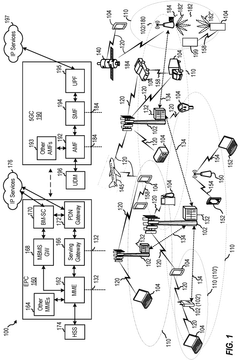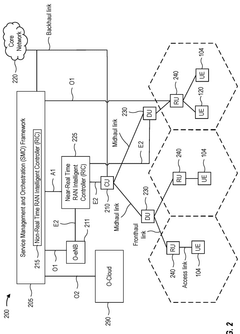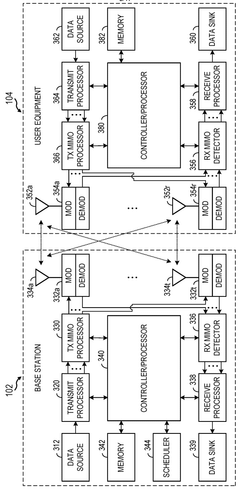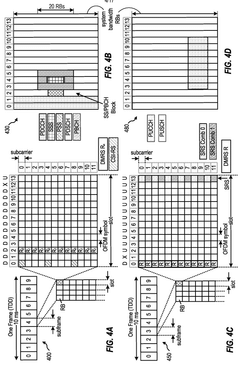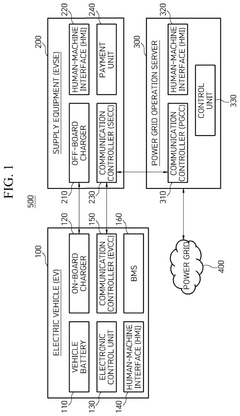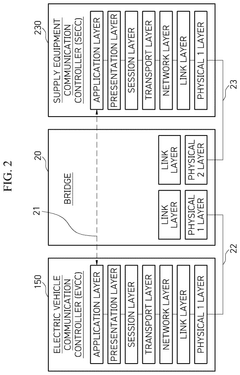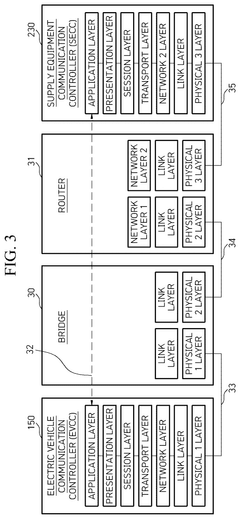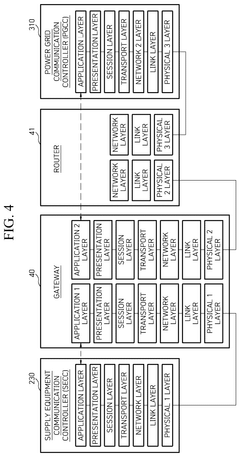Examining Technical Challenges in Vehicle-to-Grid Deployments
SEP 23, 20259 MIN READ
Generate Your Research Report Instantly with AI Agent
Patsnap Eureka helps you evaluate technical feasibility & market potential.
V2G Technology Background and Objectives
Vehicle-to-Grid (V2G) technology represents a transformative approach to energy management that has evolved significantly over the past decade. The concept emerged in the late 1990s when Dr. Willett Kempton and his team at the University of Delaware first proposed using electric vehicle (EV) batteries as distributed energy resources. Since then, V2G has progressed from theoretical concept to practical implementation, with pilot projects appearing globally around 2010 and commercial deployments beginning around 2018.
The fundamental principle of V2G technology involves bidirectional power flow between electric vehicles and the electrical grid. This allows EVs to not only consume electricity for transportation but also discharge stored energy back to the grid when needed. This bidirectional capability transforms vehicles from mere transportation assets into mobile energy storage units that can provide valuable grid services.
The evolution of V2G technology has been closely tied to advancements in several related fields, including battery technology, power electronics, communication protocols, and grid management systems. Particularly significant has been the development of more efficient bidirectional chargers and the standardization of communication interfaces between vehicles and charging infrastructure.
Current technological trends point toward increasing integration of V2G with renewable energy systems, smart grid technologies, and energy market platforms. The convergence of these technologies is creating new opportunities for grid stabilization, peak load management, and renewable energy integration.
The primary technical objectives of V2G deployment include establishing reliable bidirectional power flow capabilities, minimizing battery degradation during V2G operations, developing standardized communication protocols, and creating economically viable business models. Additionally, there are objectives related to grid stability enhancement, renewable energy integration, and reduction of overall carbon emissions from both transportation and energy sectors.
Long-term technical goals include achieving seamless integration with smart grid infrastructure, developing advanced predictive algorithms for optimal energy management, reducing hardware costs for bidirectional charging equipment, and extending battery life under V2G cycling conditions. There is also significant focus on creating standardized protocols that enable interoperability across different vehicle manufacturers, charging equipment providers, and grid operators.
The trajectory of V2G technology development suggests a future where electric vehicles become integral components of distributed energy resource management systems, contributing significantly to grid resilience, renewable energy utilization, and overall energy system efficiency.
The fundamental principle of V2G technology involves bidirectional power flow between electric vehicles and the electrical grid. This allows EVs to not only consume electricity for transportation but also discharge stored energy back to the grid when needed. This bidirectional capability transforms vehicles from mere transportation assets into mobile energy storage units that can provide valuable grid services.
The evolution of V2G technology has been closely tied to advancements in several related fields, including battery technology, power electronics, communication protocols, and grid management systems. Particularly significant has been the development of more efficient bidirectional chargers and the standardization of communication interfaces between vehicles and charging infrastructure.
Current technological trends point toward increasing integration of V2G with renewable energy systems, smart grid technologies, and energy market platforms. The convergence of these technologies is creating new opportunities for grid stabilization, peak load management, and renewable energy integration.
The primary technical objectives of V2G deployment include establishing reliable bidirectional power flow capabilities, minimizing battery degradation during V2G operations, developing standardized communication protocols, and creating economically viable business models. Additionally, there are objectives related to grid stability enhancement, renewable energy integration, and reduction of overall carbon emissions from both transportation and energy sectors.
Long-term technical goals include achieving seamless integration with smart grid infrastructure, developing advanced predictive algorithms for optimal energy management, reducing hardware costs for bidirectional charging equipment, and extending battery life under V2G cycling conditions. There is also significant focus on creating standardized protocols that enable interoperability across different vehicle manufacturers, charging equipment providers, and grid operators.
The trajectory of V2G technology development suggests a future where electric vehicles become integral components of distributed energy resource management systems, contributing significantly to grid resilience, renewable energy utilization, and overall energy system efficiency.
Market Demand Analysis for V2G Solutions
The Vehicle-to-Grid (V2G) market is experiencing significant growth driven by the convergence of renewable energy integration, grid stability concerns, and the rapid expansion of electric vehicle (EV) adoption worldwide. Current market projections indicate that the global V2G technology market could reach $17.43 billion by 2027, growing at a compound annual growth rate of approximately 48% from 2020. This exceptional growth trajectory reflects the increasing recognition of EVs as mobile energy storage units rather than mere transportation assets.
Primary market demand for V2G solutions stems from utility companies seeking to address grid stability challenges amid growing renewable energy penetration. With solar and wind power generation characterized by intermittency, V2G technology offers a compelling solution by enabling bidirectional power flow between EVs and the grid, effectively creating distributed energy storage networks. Utilities in regions with high renewable energy adoption, particularly in Western Europe, California, and parts of Asia-Pacific, are actively exploring V2G implementations to reduce peak demand charges and defer costly infrastructure upgrades.
Commercial fleet operators represent another significant market segment, driven by potential revenue generation through grid services and reduced total cost of ownership. Fleet vehicles with predictable usage patterns are particularly well-suited for V2G applications, as they can be scheduled for grid support during non-operational hours. Market research indicates that fleet operators can generate additional revenue of $1,000-$2,500 annually per vehicle through participation in V2G programs, creating a compelling business case beyond transportation services.
Residential consumers constitute an emerging but potentially massive market segment, particularly in regions with time-of-use electricity pricing or high renewable energy penetration. Consumer interest in energy independence, sustainability, and potential cost savings through arbitrage opportunities is driving adoption in this segment. Market surveys indicate that approximately 60% of prospective EV buyers express interest in V2G capabilities when presented with potential economic benefits.
Regulatory frameworks and incentive structures significantly influence regional market demand variations. Markets with favorable policies, such as the United Kingdom's vehicle-to-grid demonstration projects and Japan's post-Fukushima energy resilience initiatives, show accelerated adoption rates. Conversely, regions with regulatory barriers or insufficient price signals for grid services exhibit slower market development despite technical readiness.
The market demand landscape is further shaped by emerging applications beyond traditional grid services, including resilience during power outages, integration with smart home systems, and community-level energy sharing models. These expanding use cases are broadening the potential customer base and value proposition of V2G technologies across different market segments.
Primary market demand for V2G solutions stems from utility companies seeking to address grid stability challenges amid growing renewable energy penetration. With solar and wind power generation characterized by intermittency, V2G technology offers a compelling solution by enabling bidirectional power flow between EVs and the grid, effectively creating distributed energy storage networks. Utilities in regions with high renewable energy adoption, particularly in Western Europe, California, and parts of Asia-Pacific, are actively exploring V2G implementations to reduce peak demand charges and defer costly infrastructure upgrades.
Commercial fleet operators represent another significant market segment, driven by potential revenue generation through grid services and reduced total cost of ownership. Fleet vehicles with predictable usage patterns are particularly well-suited for V2G applications, as they can be scheduled for grid support during non-operational hours. Market research indicates that fleet operators can generate additional revenue of $1,000-$2,500 annually per vehicle through participation in V2G programs, creating a compelling business case beyond transportation services.
Residential consumers constitute an emerging but potentially massive market segment, particularly in regions with time-of-use electricity pricing or high renewable energy penetration. Consumer interest in energy independence, sustainability, and potential cost savings through arbitrage opportunities is driving adoption in this segment. Market surveys indicate that approximately 60% of prospective EV buyers express interest in V2G capabilities when presented with potential economic benefits.
Regulatory frameworks and incentive structures significantly influence regional market demand variations. Markets with favorable policies, such as the United Kingdom's vehicle-to-grid demonstration projects and Japan's post-Fukushima energy resilience initiatives, show accelerated adoption rates. Conversely, regions with regulatory barriers or insufficient price signals for grid services exhibit slower market development despite technical readiness.
The market demand landscape is further shaped by emerging applications beyond traditional grid services, including resilience during power outages, integration with smart home systems, and community-level energy sharing models. These expanding use cases are broadening the potential customer base and value proposition of V2G technologies across different market segments.
V2G Technical Status and Implementation Barriers
Vehicle-to-Grid (V2G) technology currently exists in various stages of development globally, with pilot projects demonstrating technical feasibility but widespread commercial deployment remaining limited. The fundamental V2G infrastructure comprises bidirectional chargers, communication systems, grid integration components, and energy management platforms. Despite promising demonstrations, several significant technical barriers impede large-scale implementation.
Bidirectional charging hardware presents a primary challenge, as current solutions often suffer from efficiency losses during energy conversion processes, with round-trip efficiency typically ranging from 70-85%. This inefficiency directly impacts the economic viability of V2G services. Additionally, existing bidirectional chargers are substantially more expensive than conventional unidirectional equipment, with cost premiums of 150-300% creating significant market entry barriers.
Communication protocols and interoperability issues constitute another major obstacle. The V2G ecosystem lacks standardized communication frameworks, with competing protocols like ISO 15118, CHAdeMO, and proprietary systems creating fragmentation. This heterogeneity complicates integration between vehicles, charging infrastructure, and grid management systems, hindering seamless operation across different manufacturers and utility networks.
Battery degradation concerns remain insufficiently addressed in current implementations. Research indicates that frequent bidirectional power flows may accelerate capacity loss and reduce battery lifespan by 5-15% depending on usage patterns. Without sophisticated battery management systems that can mitigate these effects, vehicle owners face uncertain long-term costs that discourage participation in V2G programs.
Grid integration challenges persist at both technical and regulatory levels. Many electrical distribution networks lack the monitoring and control capabilities necessary for managing distributed energy resources like V2G-enabled vehicles. Legacy grid infrastructure often cannot accommodate bidirectional power flows without significant upgrades, particularly in residential areas where transformer capacity may be limited.
Cybersecurity vulnerabilities represent an emerging concern as V2G systems create new attack vectors into both vehicle systems and critical grid infrastructure. Current implementations frequently exhibit inadequate encryption, authentication mechanisms, and intrusion detection capabilities, potentially exposing both transportation and energy systems to malicious actors.
Scalability remains problematic for existing V2G solutions. Most successful demonstrations have involved controlled fleets rather than diverse consumer vehicles. Scaling to thousands or millions of participant vehicles introduces complex coordination challenges for grid operators, including prediction of availability, management of competing grid services, and equitable distribution of financial benefits.
Bidirectional charging hardware presents a primary challenge, as current solutions often suffer from efficiency losses during energy conversion processes, with round-trip efficiency typically ranging from 70-85%. This inefficiency directly impacts the economic viability of V2G services. Additionally, existing bidirectional chargers are substantially more expensive than conventional unidirectional equipment, with cost premiums of 150-300% creating significant market entry barriers.
Communication protocols and interoperability issues constitute another major obstacle. The V2G ecosystem lacks standardized communication frameworks, with competing protocols like ISO 15118, CHAdeMO, and proprietary systems creating fragmentation. This heterogeneity complicates integration between vehicles, charging infrastructure, and grid management systems, hindering seamless operation across different manufacturers and utility networks.
Battery degradation concerns remain insufficiently addressed in current implementations. Research indicates that frequent bidirectional power flows may accelerate capacity loss and reduce battery lifespan by 5-15% depending on usage patterns. Without sophisticated battery management systems that can mitigate these effects, vehicle owners face uncertain long-term costs that discourage participation in V2G programs.
Grid integration challenges persist at both technical and regulatory levels. Many electrical distribution networks lack the monitoring and control capabilities necessary for managing distributed energy resources like V2G-enabled vehicles. Legacy grid infrastructure often cannot accommodate bidirectional power flows without significant upgrades, particularly in residential areas where transformer capacity may be limited.
Cybersecurity vulnerabilities represent an emerging concern as V2G systems create new attack vectors into both vehicle systems and critical grid infrastructure. Current implementations frequently exhibit inadequate encryption, authentication mechanisms, and intrusion detection capabilities, potentially exposing both transportation and energy systems to malicious actors.
Scalability remains problematic for existing V2G solutions. Most successful demonstrations have involved controlled fleets rather than diverse consumer vehicles. Scaling to thousands or millions of participant vehicles introduces complex coordination challenges for grid operators, including prediction of availability, management of competing grid services, and equitable distribution of financial benefits.
Current V2G Integration Approaches
01 Grid integration and power management challenges
V2G technology faces significant challenges in integrating electric vehicles with existing power grids. These include managing bidirectional power flow, ensuring grid stability during peak demand periods, and developing sophisticated load balancing algorithms. The technology requires advanced power management systems to coordinate charging and discharging cycles while maintaining grid reliability and preventing voltage fluctuations that could damage both vehicles and infrastructure.- Grid integration and communication challenges: V2G technology faces significant challenges in integrating electric vehicles with existing power grids. These include establishing reliable bidirectional communication protocols between vehicles and grid infrastructure, ensuring compatibility with various grid standards, and managing the complex data exchange required for efficient energy transfer. Secure communication channels are essential to prevent unauthorized access and ensure the integrity of the grid system while facilitating seamless vehicle-to-grid interactions.
- Battery degradation and management issues: One of the primary technical challenges in V2G technology is managing battery degradation caused by frequent charging and discharging cycles. Additional stress on vehicle batteries from grid services can significantly impact battery lifespan and performance. Advanced battery management systems are needed to monitor state of charge, optimize charging patterns, and implement protective measures to minimize degradation while maximizing the value of grid services provided by the vehicle.
- Power electronics and conversion efficiency: V2G systems require sophisticated power electronics for bidirectional energy flow between vehicles and the grid. Technical challenges include developing efficient bidirectional inverters/converters with minimal energy losses, managing thermal issues during power conversion, and ensuring compatibility with different charging standards. Improving conversion efficiency is critical to making V2G economically viable, as energy losses during conversion directly impact the overall system effectiveness.
- Grid stability and load balancing: Integrating large numbers of electric vehicles into the grid presents challenges for maintaining grid stability. Unpredictable charging and discharging patterns can cause voltage fluctuations and frequency deviations. Technical solutions must address load balancing, peak shaving capabilities, and grid frequency regulation. Advanced algorithms are needed to predict vehicle availability, optimize aggregated vehicle response to grid signals, and prevent localized grid overloading during high-demand periods.
- Cybersecurity and authentication systems: V2G technology introduces new cybersecurity vulnerabilities as vehicles become connected nodes in the energy network. Technical challenges include developing robust authentication mechanisms, securing vehicle-to-grid communications, protecting user data, and preventing malicious attacks that could compromise grid stability. Implementing effective encryption protocols and secure payment systems is essential for building consumer trust and ensuring the safe operation of V2G networks at scale.
02 Communication and cybersecurity concerns
Secure and reliable communication between vehicles and grid infrastructure presents major technical challenges for V2G implementation. The system requires robust protocols to protect against cyber threats and unauthorized access while ensuring real-time data exchange. Vulnerabilities in the communication network could lead to system manipulation, privacy breaches, or even grid disruptions. Developing standardized security frameworks that can adapt to evolving threats remains a critical challenge.Expand Specific Solutions03 Battery degradation and lifecycle management
Frequent charging and discharging cycles in V2G systems can accelerate battery degradation, reducing vehicle battery lifespan and performance. Technical challenges include developing advanced battery management systems that can minimize degradation while maximizing grid services, creating accurate algorithms to predict battery health, and implementing optimal charging strategies. Balancing the economic benefits of grid services against the costs of battery wear remains a significant technical hurdle.Expand Specific Solutions04 Standardization and interoperability issues
The lack of universal standards for V2G technology creates significant technical challenges for widespread adoption. Different vehicle manufacturers, charging equipment providers, and grid operators use varying protocols and interfaces, making seamless integration difficult. Technical solutions must address hardware compatibility, software interoperability, and standardized communication protocols across diverse systems. Developing unified standards while accommodating regional grid requirements and existing infrastructure presents ongoing challenges.Expand Specific Solutions05 Energy management and market integration
Integrating V2G systems into energy markets requires sophisticated energy management systems that can optimize vehicle charging and discharging based on grid needs, electricity prices, and user requirements. Technical challenges include developing predictive algorithms for energy demand, creating fair compensation mechanisms for vehicle owners, and implementing real-time energy trading platforms. The technology must balance grid stability with economic incentives while ensuring vehicle availability meets owner expectations.Expand Specific Solutions
Key Industry Players in V2G Ecosystem
The Vehicle-to-Grid (V2G) technology market is currently in its early growth phase, characterized by significant research activity but limited commercial deployments. The global V2G market is projected to reach approximately $17 billion by 2027, with a CAGR of around 48%. Technical maturity varies across key players, with automotive manufacturers like Toyota, Hyundai, Ford, and GM focusing on vehicle integration aspects, while technology companies such as Qualcomm and Intel develop communication protocols. Energy sector players including Siemens and Eaton are advancing grid integration solutions. Academic institutions like Xi'an Jiaotong University and Auckland UniServices contribute fundamental research. The competitive landscape shows automotive OEMs partnering with technology providers to overcome bidirectional charging challenges, interoperability issues, and battery degradation concerns.
Siemens Industry, Inc.
Technical Solution: Siemens has developed an end-to-end V2G ecosystem called "eMobility Grid Integration Platform" that addresses both technical and commercial challenges of vehicle-grid integration. Their solution incorporates advanced power electronics with bidirectional capabilities that achieve 96% conversion efficiency while maintaining power quality within grid code requirements. Siemens' approach features a distributed control architecture that enables coordinated management of vehicle fleets for grid services while respecting individual vehicle constraints and owner preferences. Their system includes specialized grid edge computing devices that process local grid conditions and vehicle availability to optimize V2G operations in near real-time. Siemens has implemented comprehensive communication security using TLS 1.3 encryption and certificate-based authentication to protect both grid and vehicle assets. Their platform integrates with energy market systems to enable automated participation in capacity markets, frequency regulation, and other grid service opportunities, creating new revenue streams for vehicle owners.
Strengths: Comprehensive solution addressing both technical and commercial aspects of V2G; strong integration with existing grid management systems and energy markets. Weaknesses: Significant upfront costs for infrastructure deployment; complex implementation requiring coordination across multiple stakeholders including utilities, regulators, and vehicle owners.
Ford Global Technologies LLC
Technical Solution: Ford has developed an advanced Vehicle-to-Grid (V2G) system that integrates bidirectional charging capabilities into their electric vehicle fleet. Their technical approach focuses on smart power management algorithms that optimize energy flow between vehicles and the grid based on real-time electricity pricing, grid demand signals, and user preferences. Ford's system includes proprietary hardware interfaces that enable seamless communication between the vehicle's battery management system and various grid standards across different regions. The company has implemented specialized battery conditioning protocols to minimize degradation during V2G operations, extending battery life while participating in grid services. Ford's cloud-based platform coordinates vehicle charging/discharging schedules across fleet vehicles to maximize grid benefits while ensuring vehicles maintain sufficient charge for their primary transportation purpose.
Strengths: Strong integration with existing vehicle platforms and battery management systems; extensive real-world testing through pilot programs with utility partners. Weaknesses: System requires significant infrastructure investment from utilities; potential battery warranty implications remain a concern for widespread consumer adoption.
Critical V2G Technical Innovations
Device to grid discharging and charging
PatentWO2025111073A1
Innovation
- A method for device-to-grid charge transfer that involves a controller associated with the electric grid requesting charge transfer from a wireless communication device, such as a vehicle, based on power requirements. The method includes sending a message to accept or reject the request and configuring the charge transfer accordingly.
Communication method between electric vehicle, supply equipment and power grid operation server and power transmission device embedded in electric vehicle
PatentPendingUS20240383364A1
Innovation
- A communication method and system that enables electric vehicles to transmit discharge schedules and costs to supply equipment and power grid controllers, facilitating authorization and efficient energy transfer, including a human-machine interface, on-board charger, and electric vehicle communication controller for managing energy transfer and billing.
Grid Infrastructure Requirements for V2G Adoption
The successful implementation of Vehicle-to-Grid (V2G) technology requires significant adaptations to existing grid infrastructure. Current electrical grids were primarily designed for unidirectional power flow from centralized generation facilities to end consumers. V2G systems, however, necessitate bidirectional power flow capabilities, allowing electric vehicles to both draw power from and feed power back into the grid. This fundamental shift demands substantial upgrades to physical grid components and management systems.
Power distribution networks must be enhanced to handle bidirectional energy flows without compromising stability or safety. This includes upgrading transformers, substations, and power lines to accommodate fluctuating loads and reverse power flows. Many existing transformers are not designed to handle frequent changes in power direction, potentially leading to accelerated degradation when exposed to V2G operations.
Advanced metering infrastructure represents another critical requirement. Smart meters capable of measuring bidirectional energy flows with high accuracy and temporal resolution are essential for proper accounting and billing in V2G systems. These meters must interface with both vehicle systems and grid management platforms to enable real-time monitoring and control.
Communication networks form the backbone of effective V2G deployment. Robust, secure, and low-latency communication systems are needed to facilitate rapid information exchange between vehicles, charging stations, and grid operators. These networks must support various protocols and standards while ensuring interoperability between equipment from different manufacturers.
Grid management systems require significant enhancement to incorporate V2G capabilities. Advanced Distribution Management Systems (ADMS) must be upgraded to monitor and control distributed energy resources, including electric vehicles. These systems need sophisticated forecasting algorithms to predict available V2G capacity and optimize its utilization based on grid conditions and market signals.
Protection systems and safety mechanisms must be redesigned to account for bidirectional power flows. Traditional protection schemes assume unidirectional power flow and may not function correctly under V2G conditions. New protection strategies must be developed to ensure system safety and reliability during normal operation and fault conditions.
Regulatory frameworks and grid codes need revision to accommodate V2G technology. Current regulations often do not address the unique characteristics of electric vehicles as grid assets. Updated standards must define technical requirements, operational parameters, and market participation rules for V2G systems while ensuring grid stability and reliability.
Power distribution networks must be enhanced to handle bidirectional energy flows without compromising stability or safety. This includes upgrading transformers, substations, and power lines to accommodate fluctuating loads and reverse power flows. Many existing transformers are not designed to handle frequent changes in power direction, potentially leading to accelerated degradation when exposed to V2G operations.
Advanced metering infrastructure represents another critical requirement. Smart meters capable of measuring bidirectional energy flows with high accuracy and temporal resolution are essential for proper accounting and billing in V2G systems. These meters must interface with both vehicle systems and grid management platforms to enable real-time monitoring and control.
Communication networks form the backbone of effective V2G deployment. Robust, secure, and low-latency communication systems are needed to facilitate rapid information exchange between vehicles, charging stations, and grid operators. These networks must support various protocols and standards while ensuring interoperability between equipment from different manufacturers.
Grid management systems require significant enhancement to incorporate V2G capabilities. Advanced Distribution Management Systems (ADMS) must be upgraded to monitor and control distributed energy resources, including electric vehicles. These systems need sophisticated forecasting algorithms to predict available V2G capacity and optimize its utilization based on grid conditions and market signals.
Protection systems and safety mechanisms must be redesigned to account for bidirectional power flows. Traditional protection schemes assume unidirectional power flow and may not function correctly under V2G conditions. New protection strategies must be developed to ensure system safety and reliability during normal operation and fault conditions.
Regulatory frameworks and grid codes need revision to accommodate V2G technology. Current regulations often do not address the unique characteristics of electric vehicles as grid assets. Updated standards must define technical requirements, operational parameters, and market participation rules for V2G systems while ensuring grid stability and reliability.
Regulatory Framework and Standards for V2G Implementation
The regulatory landscape for Vehicle-to-Grid (V2G) technology remains fragmented globally, creating significant barriers to widespread implementation. In the United States, the Federal Energy Regulatory Commission (FERC) Order 2222 represents a milestone by allowing distributed energy resources, including electric vehicles, to participate in wholesale electricity markets. However, implementation varies considerably across regional transmission organizations, creating inconsistent market access for V2G services.
The European Union has established a more cohesive framework through the Clean Energy Package, particularly Electricity Directive 2019/944, which explicitly recognizes energy storage services including those provided by electric vehicles. This directive mandates non-discriminatory market access for storage services, though member states' transposition of these rules shows considerable variation in practical application.
International technical standards development has progressed significantly, with ISO 15118 emerging as the cornerstone for V2G communication protocols. This standard defines the communication interface between electric vehicles and charging infrastructure, enabling bidirectional power flow control. Complementary standards include IEC 61851 for charging equipment safety and IEC 63110 for charging management protocols.
Grid interconnection requirements present another regulatory challenge, with utilities and system operators imposing varying technical specifications for grid-connected devices. IEEE 1547-2018 provides a standardized framework for interconnection but adoption remains inconsistent across jurisdictions. Additionally, metering regulations often fail to accommodate bidirectional energy flows, complicating billing and compensation mechanisms for V2G services.
Cybersecurity and data privacy regulations increasingly impact V2G deployments as grid-connected vehicles represent potential vulnerability points in critical infrastructure. The EU's Network and Information Security (NIS) Directive and the General Data Protection Regulation (GDPR) establish baseline requirements, while in the US, NERC CIP standards apply to bulk electric systems but leave gaps in distribution-level security frameworks.
Taxation and incentive structures significantly influence V2G economics. Double taxation—where energy is taxed both when drawn from and returned to the grid—remains a barrier in many jurisdictions. Progressive regulatory frameworks in Denmark and the Netherlands have addressed this issue by implementing tax exemptions for stored electricity, creating more favorable economics for V2G business models.
Harmonization efforts are underway through international bodies like the International Electrotechnical Commission (IEC) and industry consortia such as CharIN, which are working to develop global technical standards that could facilitate regulatory convergence. However, the pace of regulatory adaptation continues to lag behind technological capabilities, creating a persistent implementation gap for V2G deployments.
The European Union has established a more cohesive framework through the Clean Energy Package, particularly Electricity Directive 2019/944, which explicitly recognizes energy storage services including those provided by electric vehicles. This directive mandates non-discriminatory market access for storage services, though member states' transposition of these rules shows considerable variation in practical application.
International technical standards development has progressed significantly, with ISO 15118 emerging as the cornerstone for V2G communication protocols. This standard defines the communication interface between electric vehicles and charging infrastructure, enabling bidirectional power flow control. Complementary standards include IEC 61851 for charging equipment safety and IEC 63110 for charging management protocols.
Grid interconnection requirements present another regulatory challenge, with utilities and system operators imposing varying technical specifications for grid-connected devices. IEEE 1547-2018 provides a standardized framework for interconnection but adoption remains inconsistent across jurisdictions. Additionally, metering regulations often fail to accommodate bidirectional energy flows, complicating billing and compensation mechanisms for V2G services.
Cybersecurity and data privacy regulations increasingly impact V2G deployments as grid-connected vehicles represent potential vulnerability points in critical infrastructure. The EU's Network and Information Security (NIS) Directive and the General Data Protection Regulation (GDPR) establish baseline requirements, while in the US, NERC CIP standards apply to bulk electric systems but leave gaps in distribution-level security frameworks.
Taxation and incentive structures significantly influence V2G economics. Double taxation—where energy is taxed both when drawn from and returned to the grid—remains a barrier in many jurisdictions. Progressive regulatory frameworks in Denmark and the Netherlands have addressed this issue by implementing tax exemptions for stored electricity, creating more favorable economics for V2G business models.
Harmonization efforts are underway through international bodies like the International Electrotechnical Commission (IEC) and industry consortia such as CharIN, which are working to develop global technical standards that could facilitate regulatory convergence. However, the pace of regulatory adaptation continues to lag behind technological capabilities, creating a persistent implementation gap for V2G deployments.
Unlock deeper insights with Patsnap Eureka Quick Research — get a full tech report to explore trends and direct your research. Try now!
Generate Your Research Report Instantly with AI Agent
Supercharge your innovation with Patsnap Eureka AI Agent Platform!
